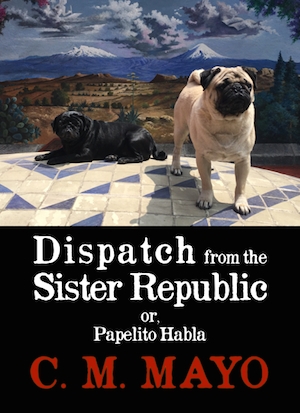
WHAT THE MUSE SENT ME
ABOUT THE TENTH MUSE,
SOR JUANA INÉS DE LA CRUZ
An
excerpt from the long essay,
"Dispatch
from the Sister Republic or, Papelito Habla"
Originally posted
on Madam
Mayo
blog,
March 20, 2017
C.M. MAYO
. |
 For
rare book collectors,
Mecca is Mexico City's Colonia Centro, and for such aficionados
of mexicana as myself, its sanctum sanctorum, the Librería
Madero—by the way, recently relocated from the Avenida
Madero to the Avenida Isabela La Católica, facing the
formidable wedding cake-white corner of the 16th century ex-convent
of San Jerónimo, known today as the Claustro de Sor Juana,
that is, the Convent of Sister Juana. For
rare book collectors,
Mecca is Mexico City's Colonia Centro, and for such aficionados
of mexicana as myself, its sanctum sanctorum, the Librería
Madero—by the way, recently relocated from the Avenida
Madero to the Avenida Isabela La Católica, facing the
formidable wedding cake-white corner of the 16th century ex-convent
of San Jerónimo, known today as the Claustro de Sor Juana,
that is, the Convent of Sister Juana.
And if you would not know Sor Juana from a poinsettia, gentle
reader, with all respect, you must crowbar out that boulder of
ignorance, for which you will be rewarded by a glimpse of the
diamond of the Mexico's Baroque period, the first great Latin
American poet and playwright, "the Tenth Muse," a cloistered
nun.
Texan poet John Campion was the first to translate Sor Juana's
magnum opus, "Primero sueño," as "The Dream,"
in 1983. (Alas, that date is not a typo.) Campion's translation
is out of print, but he offers a
free PDF download of the text on his website, worldatuningfork.com.
The first lines of Campion's translation beautifully capture
Sor Juana's uncanny power:
|
Pyramidal
death-born shadow of earth
aimed at heaven
a proud point of vain obelisks
pretending to scale the Stars
.
|
In her time Sor Juana was one of
the most learned individuals, man or woman, in the New World,
and her prodigious oeuvre, from love poems to polemics, comedies
to enigmas to plays to villancicos, was exceptionally sophisticated,
so much so that its interpretation is today the province of a
small army of sorjuanistas. As Mexico's Nobel laureate
poet Octavio Paz writes in Sor
Juana: Or, the Traps of Faith (translated by Margaret
Sayers Peden), "A work survives its readers; after a hundred
or two hundred years it is read by new readers who impose on
it new modes of reading and interpretation. The work survives
because of these interpretations, which are in fact resurrections."
And perchance startling discoveries. In his 2011 El
eclipse del Sueño de Sor Juana, Américo
Larralde Rangel makes a radiant case that her "Primero Sueño"
describes the dawn over Mexico City after a lunar eclipse on
the solstice of the winter of 1684.
In the Librería Madero I find on the first shelf, facing
out, two new books by sorjuanistas: one about Sor Juana's
family, another, just published by a Legionario de Cristo, that
purports to decipher her twenty enigmas. The latter work incorporates
a series of contemporary paintings of Sor Juana in the baroque
style—dim backgrounds, crowns and scepters of flowers, and
afloat above her head, fat-tummied cherubs, flounces, unspooling
bundles of draperies. But these Sor Juanas look too pert, make
too coy a tilt of the head. It seems to me as if, session over,
the model might have just tossed off that habit to wriggle into
some yoga wear.
Yes, just as in the United States, in Mexican cities yoga studios
have been popping up like honguitos.
But if a vision of modern Mexico would have been obscure to Sor
Juana, by no means is Sor Juana obscure in modern Mexico. She
has inspired scores of poets and musicians; there have been movies,
documentaries, and novels, most recently, Mónica Lavin's
2009 best-seller Yo,
la peor (I, the Worst—yet to be translated
into English-fingers crossed that Patricia Dubrava will do it).
As I write this in 2017, Sor Juana graces the celadon-green 200
peso bill, her portrait from the one by Miguel Cabrera in the
Museo Nacional de Historia: a serenely intelligent young woman's
face framed in a wimple, and behind her, her quills and inkpot
and an open book of her poetry-and a few lines:
|
Hombres necios que acusáis
a la mujer sin razón,
sin ver que sois la ocasión
de lo mismo que culpáis.
.
|
I cannot pretend to render the
music of Sor Juana's lines into English. But here's a rough go
at their literal meaning: You pig-headed men who accuse women
unjustly, blind to the fact that you are the cause for that which
you cast blame.
All over the Mexican Republic— from Tijuana to Tampico,
from Chiapas to Chihuahua, in cities as large as Monterrey and
Veracruz, and from small towns such as Jalpan and Xilitla in
the Sierra Gorda, to even tiny pueblitos on the far shores of
the Baja California coast,— every day some gobsmacking number
of 200 peso bills with Sor Juana's face and Sor Juana's poetry
travel from palm to palm, wallet to cash register drawer, to
back pocket, to purse, to cash register again, back to the bank
and then counted out of teller's windows and spit out from ATMs,
exchanged for tortas or tortillas, a taxi ride, a pair of jeans,
a haircut, a costal of mangos. And for paper, pens, and books.
In her lifetime Sor Juana was also famous for the range and quality
of her library. Near the end of her short life of 43 years, her
confessor obliged her to give it up, and stop writing. She died
in a plague, there behind the fortress-high walls of San Jerónimo,
her claustro.
Sor Juana's end was so ghastly
that until now, this balmy winter's day in 2017, I had never,
in all my years in Mexico City, been able to bring myself to
visit that claustro. From the Librería Madero, a copy
of her genealogy under my arm, I follow the the convent's wall
down the Avenida Isabela la Católica, and around the corner.
Leaving my driver's license in exchange for a visitor's badge,
I enter the Claustro de Sor Juana— now a university renowned
for its cooking and hotel and restaurant management school and
one of the first in Mexico to offer undergraduate and graduate
degrees in creative writing. The students, shambling along affixed
to their smartphones, could be students anywhere in Mexico: green
hair, pink hair, jeans, T-shirts.
The university's central patio, vast as a stadium, once open-air,
is covered with a sail-like white tent-roof. Other than that
roof, and the unusually large proportions, and the tic-tac of
a ping pong game, and the scattered tables of students slouching
over their laptops and smart phones, this could be an ex-convent
anywhere in Mexico, anywhere in Latin America or Spain. Arrayed
like soldiers around this central patio, ground floor and second
floor, are columns of grey stone, and behind them, evenly spaced,
the wooden doors with their decorative iron medallions, to offices
and class rooms. One of the ground floor doors stands out: it
has mouldings of grey stone. This, according to the bronze plaque
in the wall, was the cell of Sor Juana. Alas, closed for renovation.
A security guard directs me towards the chapel, where in the
left wall of the auditorium, I can view Sor Juana's remains:
A coffin behind glass. The coffin, too shiny-new to be the original,
is topped with the figure-eight of a rope of wooden rosary beads.
Above, the protective glass is etched with the words:
|
... triunfante quiero ver al
que me mata
y mato a quien me quiere ver triunfante.
.
|
More or less: ... triumphantly
I want to see the one who kills me and I kill the one who wants
to see me triumphant. These lines are from Sor Juana's poem,
"Cuál sea mejor, amar o aborrecer" ("Which
is is better, to Love or Detest"). But listen to the music
in her Spanish; note that repetition with variation, mata
and then mato.
Sor Juana had what Spanish poet Federico García Lorca
called duende. A Spanish-English dictionary will tell
you that duende means genie, pixie, fairy, or sprite—
but that is not what García Lorca meant in naming the
special power of a great artist. García Lorca's duende
is one of those words that gets hopelessly unwieldy in English.
Here's my translation: A riff from Orpheus' lyre, a spinning
chestahedron, a spadeful of soil from beneath pine duff, and
as alchemical catalysts, a moonbeam and a sunbeam and three twinkles
from Venus and Mars— then, a flamenco-move of a shove from
behind.
I take a photo of Sor Juana's coffin with my smartphone. The
photo comes out with my reflection, ghost-like, in the glass.
|
|

This is an excerpt from "Dispatch
from the Sister Republic or, Papelito Habla" my long
essay on the Mexican literary landscape and the power of the
book.
Now available in Kindle. |
 |



